Merced County Farm News WeFarm. You Eat .



January 9, 2023 - Merced County’s new District Attorney Nicole Silveira was officially sworn into office Monday, taking the reins as the county’s top prosecutor. Surrounded by friends and supporters like Merced County Sheriff Vern Warnke, Silveira took the oath at the Merced County Courthouse Museum. “Today as I take this oath, I am honored and humbled to serve as the leader of the Merced County District Attorney’s Office,” said Silveira. She went on to say “as your District Attorney, my responsibility to justice extends beyond the courtroom
and into the community to make sure that we build a safe home for all citizens of Merced County.” During the June primary election, Silveira defeated her boss, then-incumbent District Attorney Kimberly Helms Lewis for the seat, garnering nearly 70% of votes cast in her favor compared to Helms Lewis’ 30%. Silveira is a longtime prosecutor who has worked in the Merced County District Attorney’s Office since 2010. She was promoted to supervising district attorney by then-District Attorney Larry Morse II, making her the first woman to hold a management role in that office. In 2015 she was named Merced County’s Prosecutor of the Year, the
first woman to win that award. “Short term I would like to make sure that I communicate with my staff as best as possible,” said Silveira. “One of my goals was to meet with every single member of my office one-on-one and it’s something I’ve already been able to start doing and they have such great ideas so I’m really excited to work with them collaboratively to improve our office.” Long term, Silveira said she would like to expand educational services into the high schools and be proactive and supporting law enforcement analysts to help the rising number of homicides in the county. A native of Atwater, Silviera worked for many years as a
gang prosecutor. Her election platform included prioritizing crime perpetrated against Merced’s farmers; strengthening relationships with law enforcement; creating a family justice center to advocate for vulnerable crime victims; and expanding the county’s school attendance review board, which holds parents accountable for minor students’ truancy from school. Silveira graduated from Atwater High School before attending Merced College and San Diego State. She earned her law degree at California Western School of Law in San Diego. She worked in private practice before joining the District Attorney’s Office in 2010.
January 11, 2023 - After several years of severe drought, the intense storms over the last week would seemingly be a godsend to California and go a long way toward fixing the state’s water problems.
But the opposite is happening as the state is flushing out the vast majority of the incoming water into the ocean.
The big picture: Monday’s unrelenting rainfall resulted in 101,433 cubic feet per second of water inflow into the Sacramento-San Joaquin
Delta, according to data provided by the Bureau of Reclamation. The rainy first week of the year averaged around 85,000 cubic feet per second of water inflow.
• The latest available data recorded Tuesday’s inflow total 117,603 cubic feet per second.
• Yet on Monday, 95,980 cubic feet per second of water was flushed out of the delta into the Pacific Ocean, leaving a net of five percent of the incoming water to remain in the delta to be pumped and exported throughout the state.
• The three-day average for delta
water exports currently sits at six percent, meaning more than 90 percent of the incoming water is being either being retained in the Delta or (in the overwhelming majority case) flushed out into the San Francisco Bay.
The backstory: The intense flushing of water from the Delta to the Bay –rather than by pumping to Central Valley farms, storage facilities, and southern California communities – is driven by a 2019 legal document known as an “Incidental Take Permit.”
See 'Delta' Page 8
The MCFB family and Merced County ag community lost one of our most well-known and distinguished members recently. Joe Marchini, of J. Marchini and Sons, Inc passed away December 28th at the age of 84 years. Joe was a visionary and an icon in the agricultural community not just in Merced County but also leaving his mark on the ag communities statewide, nationally, and internationally. Joe also was well known for his caring and generosity, giving back to his community in many ways over many decades, and his family continues his legacy with honor. Joe will be missed by the MCFB family and so many others! Thoughts and prayers to the Marchini family for their loss. He will not be forgotten.

As I write this we are in the middle of the latest (and worst so far) round of inclement winter weather, bringing heavy rainfall and damaging winds to the area. Many areas have experienced significant flooding and while I hope and pray for the best, very likely there will have been more by the time this goes to press. In my past articles I have written some about the unfortunate ironies that exist within the world of environmental protection and policy. I have pointed out the fact that the ideologies of extreme environmentalism when put into practice often create a worse outcome for the environment than carefully planned out, fact-andreality-based actions and policies. Most of the time there’s a fairly clear picture of the differing sides or ideas regarding an environmental issue. When there are failures or negligence of one kind or another on any side of a particular issue,
it’s usually pretty easy to see where the failure occurred. Sometimes, however, it’s hard to put a finger on exactly who, what, or where is the true source of a problem or failure.
One of the most glaring and longest running issues regarding repeated, inexcusable failures in Merced County has for years revolved around the maintenance - or lack thereof - of our flood control waterways. The creeks and waterways used for flood control all have a specified capacity that has been designed and determined by environmental and hydrological engineers, typically from Army Corps of Engineers or by other independent firms, state or federal agencies working in cooperation with or under the jurisdiction of Army Corps of Engineers. These capacities in fact were determined many decades ago, and prudent policy (in fact law) has dictated ever since that adequate cleaning and maintenance of said waterways is not only necessary and vital to preserve their specified flood control capacities, but in fact required. In this case the term “cleaning” refers to 1) the clearing of any debris, trees, bamboo thickets, and dense vegetative growth that impedes the free and adequate flow of flood waters, and 2) the excavating or dredging out of sand bars that result from the massive amounts of silt that are carried and deposited by flood waters. “Maintenance” refers to the activities of repairing and shoring up creek and canal banks where needed, depositing “rip rap” (typically rocks or large chunks of broken concrete) on curves and splits to combat erosion, and the filling in of washouts, gullies, and rodent burrows that are deemed problematic. It is also imperative that this cleaning and maintenance is performed during ”dry” months of the year, when access and conditions are ideal for equipment and crews to work safely and effectively. Unfortunately, the proper and necessary cleaning hasn’t always been performed, even when desperately needed. Why? Good question. Throughout the years there have been multiple answers to that question. Usually, the answers come out in the aftermath of flood events where breaches, overflowing and flooding have resulted after a failure to get the proper cleaning done at the proper times. Usually also after lawsuits have been filed, argued, and settled. Historical and legal precedent have already been set.
Multiple times. We know the creeks and waterways need regular cleaning. We know that the flood control capacities are significantly diminished when vegetative growth within the waterway is not kept in check and controlled. We know that flood stage conditions themselves bring an unusually high amount of additional debris with them, so existing debris and overgrown vegetation only traps and builds up, further impeding flow on an already compromised waterway. We have a history of homes, farms, animals, cities, drinking water wells and environmental health in general being severely and negatively impacted by floods that occur when the creeks overflow or break.
So why then doesn’t it get done regularly? I’m certain that enough data and history exists to write an entire book about this issue, but here’s the condensed version: 1) Because of the never-ending quagmire of environmental policy and bureaucracy, and 2) because somebody somewhere along the bureaucratic chain of command fumbles the ball, either ignoring the issue until its too late or even worse, ignoring history and erroneously believing that it’s not a high priority. Environmental policy requires permits to be issued for the cleaning of the creeks. In order for the permits to be issued, environmental impact reports and studies must be carried out and presented to the various agencies, along with the detailed plans and strategies for the work needed and where. Certainly we have an obligation to perform such work with minimal detrimental environmental impact in mind. We do have the methods and technology to accomplish all of the above effectively. After all we’ve done it before quite effectively. But if the PEOPLE who are responsible for getting these things done don’t do their jobs (that they get paid handsomely to do) in a timely manner, we wind up where we are right now as I write this…right smack in the middle of a brutal storm and flood conditions with uncleaned creeks dangerously close to flood stage, and with sections ready to breach entirely, when the water levels would’ve been 3-4 feet below flood stage with proper cleaning. So where does the buck stop and who is actually at fault? Nobody really knows for sure because all the involved county, state, and elected officials just point fingers at each other constantly, and those of us who have been asking for status updates and answers, pleading for action for YEARS now can never actually get a straight answer out of any of them. The best joke of all is that the
state tells us that we are allowed to take emergency measures without permits once flood conditions are reached. That’s brilliant, folks! Let’s wait until everything is ready to wash out under high water conditions, then risk workers’ lives and expensive heavy machinery to accomplish next to nothing that’s actually effective. Furthermore, from an environmental standpoint, doing nothing in the name of protecting habitat or wildlife simply is an ineffective and regressive strategy. Environmental damage caused by flooding or breaks, then afterwards having to bring in lots of heavy equipment and do massive reconstruction is a far worse fate for the environment than simply cleaning one side of a creek every year or two. Additionally, flooded and damaged homes, fields and property that could’ve been prevented only add an exponential amount of negative impact to the environment due to the reconstruction and repair processes and demand for more resources and materials. If a tree gets cut down and a bird has to find a new tree to build a new nest, that’s a small tragedy, but that bird can rebuild a new nest in a day and get on with its life quickly…a human family that loses its home is faced with months of displacement and financial hardship. When did humans and human needs cease to be considered an integral part of the environment? Our environmental policies anymore largely disregard that the needs of people rightfully have a place in the conversations about environmental solutions and compromises.
There’s so much discussion about drought and groundwater pumping anymore that dominates local and state conversations that I sometimes think that our officials have completely forgotten that rain and storms still come, and when they do they often come with a vengeance. I’m seriously hoping that the ones who are responsible for the failures in action on this critical issue will have the intestinal fortitude to step up, admit they screwed up, and give us all a “no bull” explanation of what went wrong, why, and what they’re going to do to ensure it doesn’t continue to be a repetitive cycle of inaction or delayed action. In my opinion, these failures amount to criminal negligence at this point. Flood control must always be given its due and proper consideration and actions, ESPECIALLY during the dry years…because that’s when the conditions are most ideal in which to prepare for the wet years.
As any farmer knows, a clean ditch always carries more water!
CA MW Rises to $15.50/Hour, Ag OT Threshold Drops for Small Employers on Jan. 1 Senate Bill 3 (Leno, 2016) set in Labor Code section 1182.12 tiered increases in California’s minimum wage over the next several years. With the exception of 2017 and 2018, when the minimum wage rose by 50 cents, each year the minimum wage increased by $1 increments. Small employers (those with 25 or fewer employees) were given one additional year to comply with each wage hike.
Accordingly, in 2022, the minimum wage for non-exempt employees of small employers has been $14 per hour, and it has been $15 per hour for those of large employers (those with 26 or more employees).
Small employers who had expected the minimum wage to rise to $15 per hour received in May a rude shock from Gov. Gavin Newsom. He announced that inflation of 7.6 percent during fiscal year 2021-22, which ended on June 30, triggered a greater increase. SB 3 included that trigger, resulting in that bill’s first automatic increase in the minimum wage based on rises in the Consumer Price Index occurring in 2023 instead of 2024.
As a result, employers of all sizes will have to pay non-exempt employees at least $15.50 per hour in 2023—a hike of $1.50 per hour for small employers.
Further, per Labor Code section 515, the minimum salary for exempt employees will rise to $64,480 in 2023 ($5,774 per month or $1,240 per workweek), a significant jump for exempt employees of small employers, whose annual salary floor is now $58,240.
At the same time all employers in California will be hit with that
surprise minimum wage increase, small agricultural employers in the state will have to cope with yet another lowering of daily and weekly overtime thresholds.
As of Jan. 1, small employers (defined in the same way as for implementation of the minimum wage under SB 3) will have to pay their nonexempt ag employees one and one-half times their regular rate of pay for hours worked after nine in a workday or after 50 hours in a workweek under Labor Code section 860.
As of Jan. 1, 2022, large employers were required to pay overtime premiums on the same basis as employers of non-ag employers: time-and-half for hours worked after eight and up to 12 in a workday or after 40 in a workweek. Hours worked after 12 in a workday are compensable at twice the employee’s regular rate of pay.
And for decades, all work performed by non-exempt employees in California on the seventh consecutive day of work in a workweek has been compensable at premium rates: time-and-a-half for the first eight hours, and double time for hours worked beyond eight.
Irrigators and sheepherders lost their overtime exemptions if employed by a large employer on Jan. 1, 2019, and by a small employer on Jan. 1, 2022, respectively.
California Farm Bureau published in May a table illustrating these transitions for the increasing minimum wage and exempt-employee salary levels and decreasing agricultural employee overtime thresholds, which you can find here.
and transparency requirements.
Transparency:
Employers with 15 or more employees must now include pay scale in all job postings. “Pay scale” is defined as “the salary or hourly range that the employer reasonably expects to pay for the position.”
On an employee’s request, an employer must provide the employee with the pay scale for the position in which the employee is employed. Employers must maintain job-title and wage-history records for each employee during employment, plus three years post-employment.
Pay Data Reporting:
Employers with 100 or more employees of their own, or 100 or more employees hired through labor contractors, must file a pay data report with the state Civil Rights Department by May 10. The report must contain:
1. The number of employees by race, ethnicity, and gender in various job categories, and
2. The median and mean hourly rates within each job category by race, ethnicity, and gender. For more details, see calcivilrights. ca.gov/paydatareporting.
(Editor’s Note: Please see SB 1162: Increased Pay Data Transparency Means More Hoops for California Employers to Jump Through, Barsamian & Moody, Oct. 7, 2022.)
COVID-19 pursuant to Labor Code section 6409.6.
2. Employers may now post the notice of potential COVID-19 exposure at the worksite instead of providing written notice directly to employees. The posting must be made wherever notices to employees concerning workplace rules or regulations are customarily posted (and on existing intranet or other employee portal used for workplace postings or notices).
3. The notice must remain posted for at least 15 days.
4. A log of all postings must be kept.
AB 1751 (Daly): Extends to Jan. 1, 2024, the rebuttable presumption that an employee’s COVID-19 illness was sustained in the course of employment for purposes of workers’ compensation benefits.
COVID SPSL: The mandate for employers to provide up to 80 hours of COVID Supplemental Paid Sick Leave (SPSL) is set to expire on Dec. 31. However, the Legislature has allowed past SPSL mandates to expire only to reimpose them later retroactively. FELS will inform you if the Legislature acts to reimpose SPSL in 2023.
CA Family Rights Act & Paid Sick Leave Expansion (AB 1041, Wicks)
1. Employees may now take CFRA leave to care for a “designated person.”
WageTransparency Requirements
Signed by Gov. Gavin Newsom on Sept. 27, Senate Bill 1162 (Limon) imposes on California employers an entirely new regime of pay disclosure
COVID-19: Employee Notices, Workers’ Comp Rebuttable Presumption of Workplace Exposure, and COVID Supplemental Paid Sick Leave AB 2693 (Reyes)
1. Extends to Jan. 1, 2024, requirement for employers to provide employees with notice of potential exposure to
2. For purposes of CFRA leave, “designated person” is defined as “[a] ny individual related by blood or whose association with the employee is the equivalent of a family relationship.”
3. Employees may now take their AB 1533 three-day/24 hours paid sick
See 'FELS' Page 5
Merced County Farm Bureau is an independent, nongovernmental, grassroots organization that advocates for the men and women who provide food, fiber, and nursery products for our community, state, and nation.
Merced County Farm Bureau exists for the purpose of improving the ability of individuals engaged in production
agriculture to utilize California resources to produce food and fiber in the most profitable, efficient and responsible manner possible, guaranteeing our nation a domestic food supply.
Merced County Farm Bureau supports policies and legislation that promote and protect our Country’s number one industryagriculture for future generations and the security of our nation.
Published monhtly by Merced County Farm Bureau

Phone (209) 723-3001
Fax (209) 722-3814 646 S. Hwy 59, Merced CA 95341
Email: dflake@mercedfarmbureau.org (USPS 339-500)
Entered as Second Class matter, Jan. 20, 1948 at the US Post Office in Merced, CA. Subscription is included in membership. Singles issues are 50 cents. Merced County Farm News is printed by Wesco Graphics, 410 E. Grant Line Road, Suite B, Tracy, CA 95376
POSTMASTER: Send address changes to Merced County Farm Bureau, P.O. Box 1232, Merced, CA 95341; telephone (209) 723-3001; FAX (209) 722-3814. Merced County Farm Bureau does not assume responsibility for statements by advertisers or for products advertised in Merced County Farm News, nor does Farm Bureau assume responsibility for statements or expressions of opinion other than in editorials or in articles showing authorship by an officer, director or employee of the Merced County Farm Bureau or its affiliates.
Merced County Farm Bureau Staff
Breanne Vandenberg
Executive Director
Lorraine Passadori
Program Director
Denelle Flake
Farm News Editor/Project Specialist
Alexxis Rudich
Project Assistant/ESJ Grower Relations
Board of Directors
Pres: Joe Sansoni 761-9284
1st VP: Alan Sano 559-905-1240
2nd VP: David Barroso 652-6437
Sec/Treas: Tim Lohman 988-3545
Past Pres: Eric Harcksen 620-1953
District 1
Sean Davis 769-1804
Joe Maiorino 564-6791
District 2
Bob Vandenberg 704-5568
District 3
Mike Martin ............................ 675-1907
Chad Perry 675-4474
District 4
Jean Okuye 756-2421
Galen Miyamoto 761-5366
District 5
Brent Chipponeri 652-3473
John Van Ruler .......................648-3877
District 6
Dante Migliazzo 769-9525
Bill Arnold. 761-0542
District 7
GIno Pedretti III 756-1612
Tom Roduner 769-9353
District 8
Julie Giampaoli 201-8434
Joe Scoto 761-0489
Directors at Large
Jim Johnston 564-7551
Jeff Marchini 769-9116
Bob Giampaoli ....................... 769-4973
Dan Dewees 658-4343
Louie Bandoni 761-0625
Michael Serrano 485-1935
Mariposa County Farm Bureau Staff
FELS continued from page 3
leave to care for a “designated person.”
4. For purposes of sick leave, “designated person” has a different definition: “a person identified by the employee at the time the employee requests paid sick days.”
5. An employer may limit an employee to one “designated person” per 12-month period.

Motor Vehicle Tracking (AB 984, Wilson)
1. An employer may use vehiclelocation technology to monitor employees only if strictly necessary for the performance of an employee’s duties.
2. Monitoring is permitted only during work hours.
3. An employer must first provide notice to an employee that monitoring will occur and must allow the employee to disable the device outside of work hours.
1. California law requires certain employers that do not offer a qualified retirement plan to their employees to register for CalSavers, a state-run program that lets each employee contribute to their own Individual Retirement Account.

2. For now, this requirement covers employers with five or more employees.
3. Starting Jan. 1, employers with four or fewer employees can voluntarily register for CalSavers.
4. By Dec. 31, 2025, those employers must either offer a qualified plan or register for CalSavers.
5. Visit www.calsavers.com for details.
(AB 523, Nazarian) Effective Jan. 1:
1. Protected classes for purposes of discrimination and harassment laws explicitly include “reproductive health decision making” (defined as “a decision to use or access a particular drug, device, product, or medical service for reproductive health”).
2. Employers are prohibited from requiring applicants or employees to disclose information relating to reproductive health decisionmaking.
Parents Employing Their Children in California
Employing minors in agricultural employment can be complicated, and parents have some leeway in employing their own minor children.
California’s child-labor laws do not prohibit or prevent the employment of a minor at agricultural, horticultural, viticultural, or domestic labor during the time the public schools are not in session, or during other than school hours, when the work performed is for or under the control of his parent or guardian and is performed upon or in connection with premises owned, operated, or controlled by the parent or guardian. Cal. Labor Code, § 1394, subd. (a).
Under section 1394, the employment relationship between the parent and child is irrelevant. What is relevant is whether the work performed by the child is for or under the control of the child’s parent or guardian and is on or in connection with premises owned, operated, or controlled by the parent or guardian.
Accordingly, the parent need not be operating the farm or other ag business as a sole proprietor. If the child is working both under the parent’s control and on premises owned, operated, or controlled by the parent, the child-labor laws do not apply to the child during
non-school hours.
But the situation under Industrial Welfare Commission Wage Order No. 14-2001, which sets minimum standards for wages, hours of work, and working conditions in agricultural occupations, is different.
A complete exemption from Order 14, Section 1(B), applies to “to any individual who is the parent, spouse, child, or legally adopted child of the employer.” Accordingly, the employment relationship between the parent and child is key.
“Child … of the employer” is limited to where the child’s parent is a sole proprietor and thus “the employer.” This exemption does not apply where the employer is a subchapter S or other corporation owned or controlled by the parent, a partnership in which the parent is a partner, or perhaps even a limited liability company of which the parent is the sole member (even though the Internal Revenue Service considers such a single-member LLC as a disregard entity for tax purposes).
Mandatory Produce Safety Training (in person): The Food Safety Training Partnership, a cooperative effort of California Farm Bureau, Farm Employers Labor Service, and Safe Food Alliance, is offering produce safety
training required by the federal Food Safety Modernization Act (FSMA).

The $35 training fee is substantially supported by a grant from the California Department of Food and Agriculture.
Upcoming Dates:
Jan. 26, Stanislaus County Farm Bureau, Modesto
Feb. 1, Tehama County Farm Bureau, Red Bluff
You can find registration and more information, including additional training dates and times, at foodsafetytrainingpartnership.org. FELS Partners with Harvust to Bring You Streamlined Hiring, Training & Communication
FELS is proud to partner with Harvust, 2021 Farm Bureau Entrepreneur of the Year. Harvust offers electronic and remote software solutions for hiring, training, and communicating with your employees.
FELS subscribers can find FELS training and hiring materials ready to go on Harvust and will receive $500 free use of Harvust tools when they sign up. For information or to schedule a demo, call Harvust’s Riley Clubb at 509-424-5965, or visit www.harvust. com/fels.
SAN JUAN, P.R., January 9, 2023 — Today, at the American Farm Bureau Federation annual convention, Agriculture Secretary Tom Vilsack announced several major developments at the U.S. Department of Agriculture that will benefit farmers, ranchers and producers across the nation.
“At USDA, our goal is to provide all farmers, including new and underserved producers, with the opportunity to receive the assistance they need to continue farming, to build and maintain their competitive-edge, and to access more, new, and better markets,” said Vilsack, who spoke at the American Farm Bureau Federation annual convention today. “Working together we can ensure American agriculture is as resilient as ever and will do so by implementing a holistic approach to emergency assistance, by lowering input costs through investments in domestic fertilizer production, and by promoting competition in agricultural markets.”
Secretary Vilsack announced that USDA continues to make progress in the following areas by:
• Assisting producers facing high input costs to access domestic, innovative fertilizer capacity.
• Improving risk protection for underserved producers.
• Investing in new choices and meat processing capacity for livestock producers.
• Providing relief for producers impacted by disaster and the pandemic.
These programs and efforts are part of the Biden-Harris Administration’s commitment to lower costs for producers, increase competition and access to market opportunities, and ensure equity in designing and developing programs to help all producers. Additionally, the announcements are a continuation of the Biden-Harris Administration’s focus
on targeting assistance based on need, reaching everyone who is eligible, and removing the bureaucratic burden on producers.
USDA will soon begin accepting public comments on environmental and related aspects of 21 potentially viable projects to increase fertilizer production across the United States totaling up to $88 million. These applicants have requested grant funding through the first round of the Department’s newly established Fertilizer Production Expansion Program. This program is one of many ways the BidenHarris Administration invests in the agricultural supply chain right here at home. Investing in projects to increase fertilizer production will bring production and jobs back to the United States, promote competition and support American goods and services. Under the leadership of President Biden and Vice President Harris, USDA continues to create a competitive, resilient, secure and sustainable economy to support opportunities for local businesses and people across this nation. The Fertilizer Production Expansion Program is a critical part of that effort.
The Department is considering fertilizer production projects in Alabama, Arizona, Colorado, Florida, Iowa, Louisiana, Massachusetts, Minnesota, Missouri, Montana, Ohio, Oregon, Texas, Washington, and Wisconsin. In response to prior feedback requesting more time for public comment on the environmental and related impact of USDA-funded projects, USDA is seeking comments from the public on the following questions and projects pertaining to the National Environmental Policy Act of 1969 (NEPA) and Section 106 of the National Historic Preservation Act of 1966 (NHPA). The 30-day public
comment period will close February 8, 2023. Additional information is available at www.rd.usda.gov/fpepenvironmental-review-comments.
The Fertilizer Production Expansion Program is part of a wholeof-government effort to promote competition in agricultural markets. USDA has also released a summary of the comments (PDF, 953 KB) received through a Request For Information on Access to Fertilizer: Competition and Supply Chain Concerns, which highlights the variety of concerns about the limited competition and dependence of foreign sources for significant amounts of fertilizer.
The Noninsured Crop Disaster Assistance Program (NAP) provides financial assistance to producers of non-insurable crops when low yields, loss of inventory or prevented planting occur due to natural disasters. There is a Congressionally mandated fee waiver for basic coverage for underserved producers. However, a previous set of procedures and regulations created a paperwork burden that stood in the way of many producers taking advantage of the basic coverage option. The recent rule removes barriers and establishes procedures through which an underserved producer with a CCC860, Socially Disadvantaged, Limited Resource, Beginning and Veteran Farmer or Rancher Certification, on file prior to the applicable NAP application closing date will automatically receive basic coverage for any NAP-eligible crops they plant. Underserved producers on file for 2022 will also receive retroactive basic coverage. Like all other covered producers, underserved producers will still need to file a notice of loss and apply for benefits.
In addition to the basic catastrophic level coverage under NAP, producers can buy-up higher levels of coverage
by paying a premium. Underserved producers receive a 50 percent discount on any premiums. Producers who are interested in obtaining NAP coverage for 2023 should also contact their local FSA county office for information on eligibility, coverage options and applying for coverage. FSA also plans to target outreach to previous producers of NAP-eligible crops to ensure these producers are aware of their options. For more information, reference our NAP fact sheet (PDF, 622 KB).
USDA Making More Investments in Meat and Poultry Processing
USDA is investing more than $12 million to expand independent meat and poultry processing capacity in Ohio, Michigan and Minnesota. Vilsack announced that Meat and Poultry Processing Expansion Program grants will help fund the following projects:
• In Ohio, International Food Solutions Inc. is receiving $9,575,250 to help redevelop and expand a vacant building in Cleveland into a plant with the capacity to process 60 million pounds of poultry. The expansion will include cold and dry storage and two processing lines. The project will create 227 good-paying jobs. International Food Solutions is a womanand minority-owned business that has produced thousands of prepared meals for K-12 students receiving free and reduced-price school meals.
• In Michigan, grower-owned cooperative Michigan Turkey Producers is receiving $1,531,204 to help upgrade the hot water system, wastewater treatment facilities and refrigerated trailers to accommodate an expansion at its plant in Grand Rapids. With recent automation upgrades and the continuing
See 'USDA' Page 7
USDA continued from page 6
the former Florence Cardoza of Merced in 1942.
expansion made possible by the grant, the plant will be able to add a shift and double its processing capacity to 10 million turkeys annually. The additional capacity also will allow the plant to provide back-up for other facilities of similar size in neighboring states.
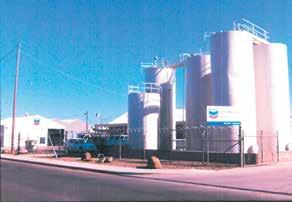
• In Minnesota, Benson + Turner Foods Inc. is receiving $962,954 to build a 6,788-square-foot cattle and hog processing plant on the

After the war, and during his life as a sweet potato farmer, he served as President of the California Sweet Potato Council, and US Sweet Potato Council, where he was a Director for over 20 years. He was the first California farmer to attend the National Sweet Potato Convention, among other industry firsts. Joe served as President of the Merced County Farm Bureau, and was on the Board of Directors of the Nisei Farmers League. He formed the California Sweet Potato Growers Co-op in Livingston, along with several other local growers, which is celebrating its 50th anniversary this year. His interests and community involvement were very diversefrom serving as a founding member of the Livingston Medical Group, to past-President of Livingston Rotary, to being
White Earth Indian Reservation and storefront near Waubun. The grant will help the company achieve its goal of building a sustainable business that benefits the local economy by using locally grown livestock and providing new opportunities for producers to market their products by providing USDA-certified processing for them.
This is in addition to recent announcements of $74 million in 22 MPPEP projects, $75 million in grants through the Meat and Poultry Intermediary Lending Program, $3.9 million in Value Added Producer Grants, and $5.7 million in Food Supply Chain Loan Guarantees, all supporting meat and poultry processing. These programs
known as the “Voice of Livingston.” From 1946 to 1996, he announced all the Livingston High School football games, lending his strong voice to the community by also announcing everything in Livingston from parades to radio programs. He served on the Livingston Elementary School Board and the Merced County Recreation Commission for many years. Joe’s acting skills even benefited the Livingston Little Theater Group, where he starred in several productions, most notably as Elwood P. Dowd in “Harvey”.
are a few of the suite of programs facilitating investment in meat and poultry processing.
On December 26, three Gustine
FFA members loaded their livestock animals and trailers and headed to Arizona until January 1st. The Arizona National Livestock Show is one of the country's largest shows; livestock exhibitors from all over the country show off their stock and compete to win. Austin Bell, Kaitlin Dores, and Emma Woods were the three Gustine FFA attendees, and they made us proud.
Austin Bell competed in the livestock judging contest and placed high in beef, hogs, and reasons. To place high in a judging contest is always a fantastic victory, but to place high out of almost 300 kids at a national show where people come from all over to compete is an even more incredible accomplishment.
Kaitlin Dores exhibited in both the junior and open beef shows and did
outstanding. Kaitlin had the junior show Reserve Champion Hereford Heifer, the open show Champion Hereford Bull, and the open show Supreme Champion Bull. To win the open show is a huge accomplishment, especially with experienced ranchers and cattlemen traveling from places as far as Indiana to show off some of the best cattle in the nation.
Emma Woods loaded up her sheep, and she did tremendously great. Emma had the honor to show the Reserve Supreme Champion Ewe. To be able to show the reserve champion ewe is a fantastic accomplishment for many reasons. Emma is an amazing sheep showman and always does her best at her shows.
We are proud of all the hard work Austin, Kaitlin, and Emma put into the projects. They all did an outstanding job at such a prestigious and prominent show. Gustine FFA is very proud of everything they accomplished in Arizona.
and booster for over fifty years. This led to his being appointed the third Area Commissioner of Baseball. All of these years of being involved in baseball in Livingston culminated in the community baseball field being renamed the “Joe F. Alvernaz Baseball Field,” something he was so proud of.
New Programs to fill gaps in 2020/2021 Natural Disaster Assistance (Emergency Relief Program (ERP) Phase 2) and 2020 Pandemic Assistance (Pandemic Assistance Revenue Program (PARP)
USDA is announcing two new programs that wrap-up and fill remaining gaps in previous natural disaster and pandemic assistance. To be eligible for ERP Phase Two, producers must have suffered a decrease in allowable gross revenue in 2020 or 2021 due to necessary expenses related to losses of eligible crops from a qualifying natural disaster event. Assistance will be
His love of baseball began at an early age and became a life-long interest that manifested itself into a devotion to the sport for over eighty years. He organized the first kid’s hardball team in Merced County in the early 50’s. He was particularly fond of American Legion Baseball, serving as a coach, sponsor, announcer
Joe was predeceased by his parents, Joe and Mabel Alvernaz, brothers, Arthur and John Alvernaz, and sister, Mary Geyer. He was also predeceased by his oldest son, Joey Alvernaz, in 1980 and by his wife of 64 years, Florence, in 2007.
He is survived by five children, Judy Blevins, James (Colette) Alvernaz, and Benjamin (Debbie) Alvernaz of Livingston; Cecelia (James) Simon of San Diego, and Susan (Randall) Wilson of Mariposa, a sister, Cecelia Luker of Atwater, 17 grandchildren and 13
primarily to producers of crops that were not covered by Federal Crop Insurance or NAP, since crops covered by Federal Crop Insurance and NAP were included in the assistance under ERP Phase One.

great grandchildren. His light on earth has dimmed, but heaven is brighter as he has joined Florence, the true love of his life.
So long to our Dad, coach, neighbor and everyone’s friend. He will be deeply and painfully missed, yet celebrated, honored and never forgotten.
To be eligible for PARP, an agricultural producer must have been in the business of farming during at least part of the 2020 calendar year and had a 15% or greater decrease in allowable gross revenue for the 2020 calendar year, as compared to a baseline year.
In lieu of flowers, the family requests that donations may be made to Grace Nursing Home in Livingston or to the Joe F. Alvernaz Memorial Fund to benefit youth baseball in Livingston.
The ERP Phase 2 and PARP application period is open from January 23, 2023 through June 2, 2023. For more information, producers should contact their local USDA service center or reference the ERP Phase 2 fact sheet, PARP fact sheet or the ERP Phase TwoPARP Comparison fact sheet.
Sweet Potato Joe was the Farm Bureau President from 1983-1986 and hired long-time staff member Lorraine Passadori when she showed up in her clown costume for the interview. Agriculture lost a strong advocate that will truly be missed. We will continue to keep his family in our thoughts and prayers.
Delta continued from page 1
• The document, which was designed by the Newsom administration to counter a sweeping (and nowrescinded) 2019 update to Federal environmental rules governing the operation of the Sacramento-San Joaquin Delta, requires flushing of water when Delta flow intensifies between December 1 and January 30.
• The first flush provisions of the permit are triggered in two scenarios:
• When the three day running average of water flowing into the Delta via
the Sacramento River at Freeport meets or exceeds 25,000 cubic feet per second and turbidity in those flows meets or exceeds 50 Nephelometric Turbidity Units
• Or, in the alternative, the Smelt Monitoring Team (an amalgam of representatives from the U.S. Fish and Wildlife Service, California Department of Fish and Wildlife, Bureau of Reclamation, Department of Water Resources, and State Water Resources Control Board) determines that conditions pose a high risk of delta smelt migration into areas of entrainment.
• Sources told The Sun that the first flush provisions were initially triggered on Jan. 3.
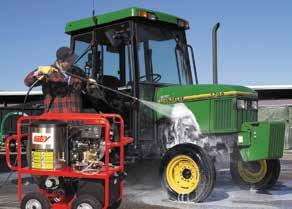

January 12, 2023 - Sacramento, CA — The Mother Lode’s recently elected state Senator, Marie Alvarado Gil, has received her assignments for the new legislative session.
Notably, Alvarado Gil, a Democrat, will be the Chair of the Human Services Committee.
She says, “I am honored to be chosen to lead the Human Services Committee and be an active member in the other six committees. I am ready to get to work and eager to collaborate with my colleagues to create bipartisan policy
solutions for both California and the 4th Senate District.”
Other committees in which Alvarado Gil will be a member include Agriculture, Business, Professions and Economic Development, Governmental Organization, Insurance, Military and Veterans Affairs, and the Joint Committee on Fairs Allocation and Classification.
Alvarado Gil, who resides in Amador County, was recently sworn into office.
District Four includes the counties of Alpine, Amador, Calaveras, El Dorado, Inyo, Madera, Mariposa, Merced, Mono, Nevada , Placer, Stanislaus, and Tuolumne.
• Once triggered, the Department of Water Resources is to reduce exporting water out of the Delta south into the San Joaquin Valley for 14 consecutive days. What they’re saying: In response to the current crush of storms and on-going flush operations, California Republicans – including Rep. David Valadao (R–Hanford), Rep. John Duarte (R–Modesto) and Rep. Tom McClintock (R–Elk Grove) – sent a letter to President Joe Biden and California Gov. Gavin Newsom urging them to waive the impediments to the delta pump operations to ensure that none of the current rainfall goes to waste.
• The lawmakers also asked Biden and Newsom to prioritize and
expedite water storage projects.



• “The past few years of catastrophic man-made drought have crushed California families and farms, and with supply chain disruptions further hamstringing our agricultural producers, we have a moral obligation to provide Californians any relief that is within our control,” the lawmakers wrote. “Government regulations should not and must not deny our constituents critical water from these storms. While we cannot make it rain, we must take advantage of opportunities to store water when it does and maximize what can be moved at all times through the Delta for the duration of these storms.

December 12, 2022 - Merced County is getting a new agricultural commissioner.

Sean S. Runyon will serve in the position starting Jan. 2, receiving an annual salary of $153,732. He has worked under outgoing commissioner David Robinson since 2016, and has been with the County in the office of the agricultural commissioner since 2011.
“We’re really pleased with the outcome of our recruitment,” said County Executive Officer Raul Lomeli Mendez. “Succession planning at its
best. This is the way it’s supposed to work out.”
The Agricultural Commissioner enforces state food and agricultural regulations, and is headquartered in Merced with a satellite office in Los Banos. The office employs around 30 people. Agriculture is the county’s top money maker, valued at almost $4 billion every year.

Robinson, who has been with the county for over 19 years, originally came from Madera County where he worked for 14 years.
“Merced took me in as an assistant ag
commissioner, and I want to say thank you to the board and previous boards for the support they gave to me personally,” Robinson said.
He talked about the need to train a successor for the position. Runyon has worked closely with Robinson over the past six years.
“The legacy part of the job is the most important to us,” said Supervisor Lloyd Pareira. “Thank you for mentoring [Runyon].”
“I couldn’t have gotten to this point without him. He’s been an incredible mentor,” said Runyon, referring to
Robinson. “I really got to watch him work and it’s been a huge benefit to my development.”
“[Agriculture] is such an important, vital part of our economy,” Runyon said. “Over the last couple of years it’s really become evident how important a safe, sustainable food supply is to the world. With everything that’s going on nowadays with Ukraine and pandemics, hopefully when people look at their groceries they realize all the hard work it takes to bring that food to the table.”
Robinson is retiring at the end of December.
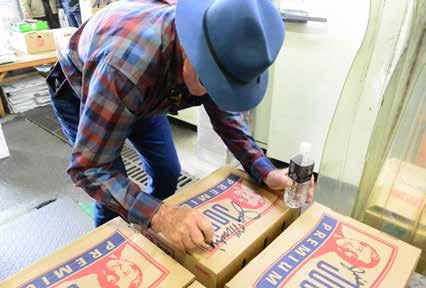
Joe left an impression on everyone that met him, we are so fortunate to hear people speak about Joe.” Joe Man, as he was known, will be forever remembered for his local community involvement, as an innovator, and for his contributions in the agricultural industry.

Joe’s life was filled with family, farming, his faith and of course a lot of fun along the way. His legacy will live on through J. Marchini Farms and his family will continue to make him proud.
Joe leaves behind his adorning wife Julie, his children Lisa (Adam), Jeff (Stephanie) and Fania (Robert) along with his 10 grandchildren, and 10 greatgrandchildren with another on the way.
If you wish to share your thoughts, memories, and condolences, simply emails us at marketing@jmarchinifarms. com
Please follow @joespremium on Instagram and Facebook.
By: J. Marchini FarmsJoe (Giuseppe) Marchini, who founded J. Marchini Farms of California based company specializing in radicchio and Italian specialties passed away at the age of 84 surrounded by family on December 28, 2022.

Joe Marchini’s farming career may have ended with radicchio; but it all began with tomatoes. His parents, Florindo and Elisa Marchini, made a long and uncertain journey from Lucca, Italy in the 1920s. They settled in Le Grand, California where he met Carlo Giampaoli and founded the GiampaoliMarchini Company, a grower-shipper of the Live Oak Brand of tomatoes. As a boy, Joe enjoyed being outside and watching his father farm, so it was practical for him to grow an 11-acre crop of tomatoes at age 13. In the 1960s, Joe was offered his father’s shares of ownership in the Giampaoli – Marchini operation and started farming on his own and expanded to farming bell peppers, onions, and almonds in the seventies and eighties.
Joe’s passion for the Italian culture and fluency in the language allowed
him to make connections with Italian growers, learning radicchio seed variety suggestions and growing techniques. In the 1980s, Joe grew his first successful radicchio crop and actually drove radicchio loads to San Francisco himself to increase the market’s awareness. From then on, Joe’s Premium brand was known as “The original radicchio grower of the United States”.
The 1990s and early 2000s were about consistency. The father and son duo of Joe, and Jeff of J. Marchini Farms, concentrated on perfecting the radicchio operation to ensure a year-round supply to the US market. Marketing came naturally to Joe as he is the man on the Joe’s Premium logo. Joe was adored by chefs along with local and international produce buyers throughout the decades. As the radicchio operations continued to grow, Joe was proud to see his son and grandchildren working by his side.
In 2012, Joe was diagnosed with cancer and the odds were tough, but Joe’s resilience, faith and family gave him strength.
The Marchini family states “We are devastated but the light still shines as
Platinum Heritage Members
Grimbleby Coleman CPAs Holt Ag Solutions





Minturn Nut Company
Valley Pacific Petroleum Services Inc.



Turlock Irrigation District
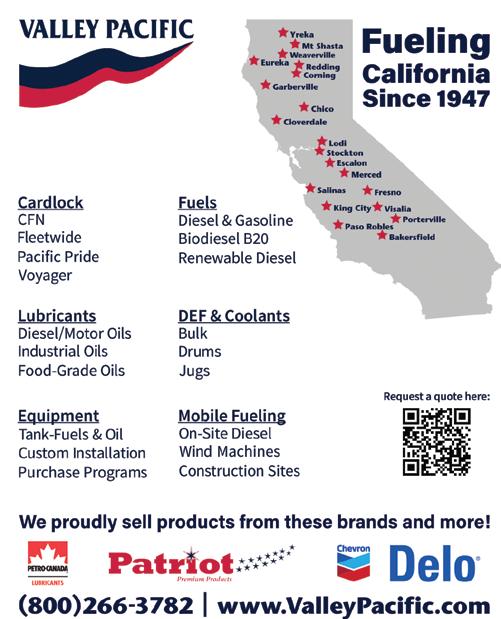

January 11, 2023 - Agricultural groups and producers have plenty to watch in 2023 when it comes to federal regulations or guidance that might affect farm operations.
According to some of those groups and the government’s own plans, issues to keep an eye on include the everpresent “waters of the U.S.” definition, renewable fuels, food safety, and emissions from animal operations.
But first, PFAS, a family of thousands of chemicals also known as per- and polyfluoroalkyl substances or “forever chemicals” because they don’t break down naturally in the environment. EPA has proposed designating two of the most widely used, PFOA and PFOS, as hazardous substances under CERCLA, the nation’s Superfund law.
The American Farm Bureau Federation was direct in its November comments warning EPA that the designation would impact farmers by automatically triggering cleanup liability.
“Farmers and ranchers are in no position technically, economically or practically to address the impact of the presence of PFAS chemicals and especially PFOA and PFOS which continue to be found in virtually any place where soil, surface and groundwater has been tested,” the Farm Bureau said, urging the agency to withdraw the proposal and instead use its authority to set drinking water and pollutant discharge standards to address the issue.
Contributing to the ag sector’s concerns is farmers’ widespread use of biosolids as fertilizer, AFBF said. Numerous studies have shown biosolids contain PFAS, and farms in New Mexico, Maine and Michigan have faced financial collapse when the chemicals were found in milk from dairy cows and beef cattle. "Designating these chemicals as a ‘hazardous material’ before setting a regulatory standard for biosolids is very concerning," AFBF said.
“The concern here is certainly land values, because if you have a contaminated field, you have lost the value of your land,” Courtney Briggs, a senior director of congressional relations
for AFBF, said at the group’s annual meeting in San Juan, Puerto Rico, this week.
“Let me just be clear,” Briggs said. “As you know, farmers do not in any way at any point in their operation, use PFAS. It just arrives at a farm field through the water supply or through biosolid use. We are the victims here. I call us ‘passive receivers.’”
EPA is planning to release a biosolids risk assessment in late 2024, which could serve as the basis for a future biosolids regulatory standard, and “might provide a CERCLA defense to the biosolids liability going forward, but would not provide liability relief retrospectively,” AFBF said in its comments.
“EPA’s proposal to exercise its never before used CERCLA remedial authority to designate PFOA and PFOS as CERCLA hazardous substances to address the ubiquitous contamination of the environment, including agricultural lands, is the wrong tool to deploy at this time,” Briggs said.
EPA also will be reconsidering an exemption from reporting emissions from animal operations under the Emergency Planning and Community Right to Know Act, or EPCRA. The National Cattlemen’s Beef Association is one group that “will be closely engaged in any related rulemaking,” Mary-Thomas Hart, NCBA’s government affairs chief counsel, said.
And of course, EPA will also be busy working on its regulatory approach to WOTUS, the definition of “waters of the U.S.” under the Clean Water Act. Environmental groups have largely praised the EPA and Army Corps of Engineers’ proposal for its recognition of ephemeral streams, among other changes to the Trump administration’s Navigable Waters Protection Rule, but farm groups and farm-state lawmakers have been critical, calling the proposal an overreach.
They also say EPA and the Corps should have waited until the Supreme Court issues its Sackett opinion, which is likely to force the agencies to reexamine its regulations.
“With the final rule out, the real work begins,” Hart said. “We’ll be watching EPA as they develop implementation guidance related to the December 2022 rule, while simultaneously waiting
for the Supreme Court’s decision in Sackett. Of course, the direction taken by the court will significantly impact the agency’s workload for the second half of 2023.”
The ag and food industries also are monitoring a proposal from the Securities and Exchange Commission that would require reporting by public companies of Phase 3, or supply chain greenhouse gas emissions.SEC Chair Gary Gensler emphasized at a Senate hearing in Septemberthat the regulations aren’t targeted at farmers, but at public companies that have pledged to reduce GHG emissions or those where GHG emissions are expected to have a “material impact” on their businesses.
But Hart said the proposed rule “could implicate thousands of businesses that have never been subject to SEC reporting, including farms and ranches.” She said the agency will need to look at the implications of a recent Supreme Court decision (West Virginia v. EPA), which she said “will have a significant impact on agencies’ ability to write climate-related regulations without a clear statutory mandate.”
“It will be interesting to see what, if any, changes are made by the agency to comply with the West Virginia decision and address concerns brought up by supply chain participants,” she said.
Meetings are scheduled at OMB in the new year on requests from nine states to allow the use of E15 gasoline in the summer months. Illinois, Iowa, Kansas, Minnesota, Missouri, Nebraska, North Dakota, South Dakota and Wisconsin have sought a rule from EPA, action many have cited as an impetus for House and Senate lawmakers to introduce bills to allow year-round use late last year with the backing of the American Petroleum Institute.
In addition to those issues, several other regulatory actions important to agriculture have been forwarded to the Office of Management and Budget for review. Here are just a few highlights:
Most recently, OMB began examining a proposal from the Food Safety and Inspection Service to allow voluntary labeling of products with “Product of USA” and similar statements. The agency also is looking at a proposed framework to reduce
Salmonella in certain not-ready-to-eat stuffed chicken products.
In early August, OMB received for review a final rule on strengthening enforcement of the Organic Foods Production Act. And in late October, it received a proposed rule from USDA on making school meals consistent with the 2020 Dietary Guidelines for Americans. Two meetings have been held involving OMB officials — one with representatives of the International Dairy Foods Association and one with public interest groups, including the Center for Science in the Public Interest, Academy of Nutrition and Dietetics, and American Heart Association.
Under the category of reviews that have been going on since early 2022, OMB also is reviewing draft FDA guidance for industry on the labeling of plant-based milk alternatives and voluntary nutrient statements. The agency received the documents on March 31, 2022, and six meetings were held in May and June with stakeholder groups and companies.
Edge Dairy Cooperative is among many dairy entities concerned about the proliferation of plant-based liquids identified as “milk.”
“Dairy products are safe, wholesome and nutritious and should be accurately represented to customers as such,” the cooperative said in an announcement of its priorities for 2023. “While there is room for a variety of products in the marketplace, it is wrong to mislead customers. Some non-dairy imitations violate existing labeling laws.”
FDA, which has been criticized for the pace of its regulatory review of cannabidiol, or CBD, has also sent to OMB guidance for industry on “quality considerations for clinical research” of cannabis and cannabis-derived compounds.
The regulated industry also will be watching closely to see how FDA Commissioner Robert Califf plans to reorganize the agency to give food and nutrition issues more attention. A review conducted by the ReaganUdall Foundation of the human foods activities at FDA found a lack of clear direction and leadership have
See 'Regs' Page 14
continued from page 13
all contributed to yearslong delays of decisions on guidance and regulations.
The report recommended Califf establish a clear leadership structure for the foods program, with one possibility being a deputy commissioner for foods, an option favored by a diverse set of trade associations, public health groups
and state regulators.
The report also said FDA needed to be more transparent about its decisionmaking process.
Califf said FDA will provide a public update on a “new vision” for the program at the end of January “and additional public updates by the end of February 2023.”
Califf also has pledged to review the agency’s policy on feed ingredients, which has been criticized for treating the
ingredients as drugs, delaying approval of substances that could reduce cattle’s methane emissions.
Six meetings were held at OMB in September and December to discuss the contents of a final rule sent from the Labor Department in November that would change the way it determines the Adverse Effect Wage Rates (AEWRs) for non-range agricultural occupations.

Among the interested parties: Farmworker Justice, National Council of Agricultural Employers, and Custom Harvesters Inc. Ag employers are concerned the methodology proposed would result in their paying too much for labor, while farmworker advocates say the “prevailing wage” system, used to determine the minimum employers are supposed to pay, needs to be fixed because most states have not set such a wage.
Januray 10, 2023 - Shipping and supply chain woes are not the only headwinds facing U.S. agricultural goods. Proposed rules in the European Union are causing concern with American almond producers and the federal government.
Lower maximum residue level limits and food labeling rules are among the top concerns facing U.S. almond producers, according to Sara Garcia Figuera, a technical consultant with Prospero & Partners.
Prospero & Partners began consulting with the Almond Board of California in the summer of 2021, offering timely intelligence about some of the ongoing initiatives that could affect almond imports into the European Union.
The issues stem from the EU Green Deal, an effort striving to make Europe the first climate-neutral continent. The plan is said to be an overarching roadmap for all EU policies through 2024 that aims to eliminate greenhouse gas emissions by 2050 and decouple economic growth from resource use.
The EU Green Deal covers many policy areas, she said during a panel discussion at the recent almond conference in Sacramento, Calif. Included in the plan are several farm-to-fork goals that aim to reduce food loss and waste, improve food production, processing, and distribution sustainability, and make food consumption more sustainable.
Perhaps the most controversial plan in the farm-to-fork proposal is a 50% reduction in the use of pesticides by
2030.
“This has been one of the most controversial targets because we’re already in 2022,” she said in early December.
“There’s an ambition to reduce nutrient losses by 50%, reduce the use of antimicrobials of livestock production by 50%, and then increase the overall agricultural area under organic farming to reach 25% by 2030,” she continued.
Ideas disappointing
Clay Hamilton, associate administrator of the USDA’s Foreign Agricultural Service, called these ideas of the EU disappointing.
“The way they seem to do things in Brussels is that they come up with aspirational regulations, put them into place, lock them in, and then figure out how they’re going to work,” he said during the panel discussion.
Hamilton went on to say that USDA Secretary Tom Vilsack previous agreed that while improvements can and should take place, if these changes are not profitable for farmers, they won’t work.
“They don’t seem to focus on that in Brussels,” Hamilton said. “They’re not listening to farmers when they say this doesn’t make sense.”
Hamilton says the U.S. is trying to promote science-based decisions in Europe and elsewhere when it comes to export regulations.
“We’re trying to get not just Europe, but all countries to focus on how we can do this,” he said. “How can we be sustainable, work together to preserve the planet, and feed eight billion people? Europe is very inward-focused.”
Another issue within the EU is
the “mirror clauses” the union seeks. This would require a one-size-fits-all approach to import rules across the entire EU.
Jonathan Hoff of Monte Vista Farming in Denair, Calif., said these requirements are causing confusion among his customers.
“In a lot of cases, our customers are confused about what all these regulations actually mean and how they’ll be implemented in the same way,” he said. “They’re sort of looking to us as a resource to tell a story about how we’re complying with something that doesn’t fully exist yet.”
December 29, 2022SACRAMENTO, Calif. —
Large trucks and buses made before 2010 will be prohibited from operating on California roadways starting Jan. 1. It's the final rule in a set of clean air regulations the California Air Resources Board passed nearly 15 years ago.
The rule applies to diesel vehicles that weigh at least 14,000 pounds. The air resources board said there are an estimated 200,000 vehicles that have yet to comply with the rule just days before the new year, including roughly 70,000 big rig trucks, or about 10% of the commercial motor vehicles operating in the state, according to trucking lobbying groups.
Why is California banning some big rigs from the road?
The air resources board has said 2010 and newer engines do a better job of filtering out harmful particulate matter.
"When we passed the regulations in 2008, it was to reduce community exposure of toxic air contaminants, it is 100% to protect public health," said
Gerald Berumen, spokesman for the air resources board.
State regulators have said that while big rigs make up about 6% of vehicles registered in the state, they account for more than half of the pollution emitted from mobile sources.
To enforce the new rule, the California Department of Motor Vehicles will deny registration for vehicles that are not in compliance. The air resources board said it also has an enforcement unit that will audit fleets, do inspections, and issue citations if necessary. The agency is also working with the federal Environmental Protection Agency to help enforce the rule for vehicles coming from out of state.
Those who keep the vehicle but have the engine replaced with an engine made 2010 or later would be exempt from the rule.
Trucks and buses that drive less than 1,000 miles per year in California may qualify for a low-use exemption from the rule, or those operating in what is designated as a low oxides of nitrogen (NOx) emissions areas.
The air resources board suggests anyone having issues complying with
the rule to contact the agency as soon as possible.
How has the trucking industry responded?
Earlier this year, as supply chain issues persisted and ports across the state were clogged, trucking lobbying groups requested the air resources board delay implementing the rule for a year.
"One of the things that really affects us in trucking is CARB’s lack of wanting to deal with this issue," said Joe Rajkovacz, director of government affairs for the Western States Trucking Association. "During the pandemic, truckers were viewed as heroes, truckers kept things rolling."
Rajkovacz said as a result of the pandemic, the used big rig market is similar to the used car market right now: unaffordable for many, especially for small to medium trucking businesses. He noted California truckers would have to buy up 100% of the used market in the United States to comply with the new rule, which he said is impossible.
"We as an association are seeing members drop because of this rule, they’ve simply decided they’re not going to go out and spend $150,000
dollars on a truck that could lead them to bankruptcy," Rajkovacz said.
New truck purchases are also hard to come by, with many truck makers closing order books early in the year, which Rajkovacz noted further complicates the issue.
The industry is bracing for even more regulations that could affect trucking fleets across the state and country, as state regulators eye phasing out the sale of new diesel and gas-powered engines over the next two decades.
"Do we think that is the future? Yes," Rajkovacz said. "It’s an aspirational rule but nobody believes it’s building a bridge to the future, not when you’re trying to force a change."
With 10% of the state’s commercial motor vehicles affected by the change, it’s unclear how the rule taking effect in the new year will impact the state and nation’s supply chain.
"Many of us would have thought the consequences of California’s goods movements could be severe," Rajkovacz said. "You can’t take that big of a percentage of the vehicles off the road, but with the slowdown in the economy, it remains to be seen what the impact will be."
January 9, 2023 - California Farm Bureau President Jamie Johansson applauds California’s Kevin McCarthy on his election as Speaker of the U.S. House of Representatives.
“As a former member of the House Agricultural Committee who hails from California’s vital Kern County farming region, Speaker McCarthy has long been an advocate for farmers and ranchers in the Golden State,” Johansson said.
“He understands the importance of the
nation’s leading agricultural economy and its bounty of ‘California-Grown’ products, which feed America and the world beyond. We look forward to partnering with Speaker McCarthy on key issues to help California farmers, ranchers and agricultural businesses
prosper for generations to come.”
The California Farm Bureau works to protect family farms and ranches on behalf of nearly 29,000 members statewide and as part of a nationwide network of 5.3 million Farm Bureau members.
On Tuesday, January 10th, Governor Newsom unveiled a summary of his proposed budget for the 2023-2024 fiscal year. This upcoming fiscal year will face significant economic headwinds with an initial $22.5 billion deficit with the potential to increase by the time May revise comes around. It is interesting to note that the Governor’s budget does not currently propose to draw from the current reserves of $35.6 billion until there is clarity on our economic condition before May. As we engage in the coming weeks and months with the legislature and stake holders, we will continue ensure that investments made related to California Agriculture continue to be a priority. Below are specific items in Governor Newsom’s proposed budget relevant to agriculture.
The Governor’s proposed 2023-24 budget provides $11.7 million special funds and 42 positions in 2023-24 and $6.5 million special funds ongoing to help address wage claim processing times and automate portions of the claims processing activities within the Wage Claim Adjudication unit.
The Agricultural Labor Relations Board has submitted a Budget Change Proposal (BCP) requesting an additional $1.113m to fund three new attorneys and three new field examiners to implement the Card Check bill signed by Governor Newsom (AB 2183). It is unclear if this BCP anticipates workload changes that could result if the Legislature passes revisions to AB 2183 jointly announced by the Governor, the California Labor Federation, and the United Farm Workers when the Governor signed AB 2183.
Department of Food and Agriculture
( Attached is a current list as of January 10, 2023 CDFA program funding, funding reductions and budget change proposals )
Due to the nature of this year’s budget many departmental programs were subject to changes and funding reductions. The January proposal protects 90% of General Fund investments from 2021-22 and 2022-23 for Departmental Programs. Here are a few examples of the proposed budgetary
allocations. Programs which remain fully funded
• Farm to School Incubator : $90 million
• Water efficiency Technical Assistance: $20 million
• Livestock Methane Reduction Program (AMMP/DDRDP): $48 million
Programs with funding reductions:
• State Water Efficiency and Enhancement Program (SWEEP): $40 million reduction, leaving $70 million for next solicitation
• Healthy Soils Program: $15 million reduction, leaving $70 million for next solicitation
• Pollinator Habitat Program: $15 million reduction for 2022-23, leaving $15 million for the previous 2021-22 solicitation
Cannabis
$83.9 million Cannabis Tax Fund is allocated to the Board of State and Community Corrections through Allocation 3 to award grants to local governments to assist with law enforcement, fire protection, or other local programs.
• $6.4 million Cannabis Control Fund and $5.7 million in other special funds, which will increase over time to
• $13.1 million Cannabis Tax Fund and $6.6 other special funds, to continue the State Water Resources Control Board's statutorily mandated efforts to address water quality and instream flow-related impacts from cannabis cultivation.
• $3.8 million Cannabis Control Fund and $4.2 million Fish and Game Preservation Fund to continue the Department of Fish and Wildlife’s Cannabis Regulatory and Enforcement Program.
The budget includes $897 million in General Fund reductions and $370 million in General Fund delays to future years. If there is sufficient General Fund in January 2024, up to $410 million of these reductions will be restored. This lowers the funding provided for energy programs provided in the 2022 Budget Act from $7.9 billion to $7 billion. Key changes to the funding include the
following:
Reverts $400 million in California Emergency Funds in 2022-23 to the General Fund, for savings from the California Arrearage Payment Program, based on actual applications received and approved for funding.
• Reduces $270 million General Fund in 2023-24 from the Residential Solar and Storage program at the Public Utilities Commission. This maintains approximately $630 million (70 percent) for solar and storage incentives for low-income utility customers.
• Reduces the Long Duration Energy Storage Program at the California Energy Commission (CEC) by $50 million General Fund, or 13 percent.
• Decreases the Carbon Removal Program at the CEC by $25 million, a 25 percent reduction.
• Decreases the Transmission Financing Program at the California Infrastructure Bank by $25 million in 2023-2024, or 10 percent.
• Cuts the Low Global Warming Pollutant Refrigerants program at the Air Resources Board by $20 million, or 50 percent.
• Reduces the Food Production Investment Program at the CEC by $10 million in 2022-2023, or 13 percent.
• Cuts the Industrial Grid Support and Decarbonization Program at the CEC by $10 million in 2022-23, or 10 percent.
• Delays $370 million of funds in the current year and the budget year to future years for the Equitable Building Decarbonization Program at the CEC. Eliminates $87 million in 2025-26, or 9 percent of the multi-year total.
SB 846 (Dodd) proposed $1 billion over three years beginning in 202324 for a Clean Energy Reliability Investment Plan, subject to later appropriation. The budget proposes an initial allocation of $100 million in 2023-24 from SB 846 Clean Energy Reliability Investment Plan funds. Delays $150 million in the current year and the budget year to 2026-27 for the Climate Innovation Program at the CEC.
SB 1020 (Laird, Atkins, Caballero and Durazo), the budget includes $4 million from various funds (General
Fund, Cost of Implementation Account, Greenhouse Gas Reduction Fund, and Public Utilities Commission Utilities Reimbursement Account) in 202324, and additional ongoing funds, across multiple agencies to support implementation for advancing new clean energy targets.
Rural Broadband
The 2021 Budget provided $6 billion over three years as part of a statewide plan to expand broadband infrastructure, increase affordability, and enhance access. Of this amount, $3.25 billion was provided to the California Department of Technology (CDT) for the purpose of building an open-access middle-mile network in unserved and underserved areas of California.
The 2023-24 Budget maintains the same level of funding for broadband middle-mile, last-mile, and the Loan Loss Reserve Fund activities. However, to address the budget problem, the Budget proposes:
• Deferral of $550 million at the CPUC for last-mile infrastructure grants in 2023-24 to future years ($200 million in 2024-25, $200 million in 2025-26, and $150 million in 2026-27)
• Deferral of $175 million from 202223 and $400 million from 2023-24 for the Loan Loss Reserve Fund at the CPUC to future years ($300 million in 2024-25 and $275 million in 2025-26).
Includes $10 million (Opioid Settlement Fund) for fentanyl program grants to increase local efforts on education, testing, recovery, and support services associated with the implementation of
• AB 2365 (Patterson, Chapter 783, Statutes of 2022).
• Proposes $4 million to support innovative approaches to make fentanyl test strips and naloxone more widely available.
Reduces ZEV spending adopted in the 2021 and 2022 budgets by 11 percent from $10 billion to $8.9 billion. This
See 'Farm Bureau at work' Page 17
continued from page 16
includes $2.5 billion in General Fund reductions, offset by a fund shift of $1.4 billion to the Greenhouse Gas Reduction Fund (GGRF). It also includes a mechanism to allocate additional discretionary GGRF funds toward ZEV programs. Specific program changes include:
• Reduces equitable zero-emission vehicle and infrastructure funds by $745 million from the General Fund, offset by a $535 million fund shift to GGRF. This equals a 9 percent reduction.
• Reduces ZEV mobility programs by $184 million in General Fund, with an offset of $25 million from GGRF. This equals a 53 percent reduction.
• Reduces heavy duty ZEV investments by $1.5 billion from the General Fund, offset by an $839 million offset from GGRF. This equals an 11 percent reduction.
• Reduces emerging opportunities and federal programs by $133 million in General Fund, with an offset of $40 million in GGRF. This equals a 7 percent reduction.
Expresses intention to work with the Legislature to extend the AB 8 (Chapter 401, Statutes of 2013) fees that fund ZEV infrastructure and vehicle incentives.
Proposes reductions over three years to future transportation and transit infrastructure funding as follows:
• Reduces planned funding in 2023 and 2024 from $2 billion each year to $1 billion in 2023 and $500 million in 2024 and 2025. States that if there are sufficient revenues, these funds will be restored.
• Reduces $500 million from General Fund, with a $300 million reduction restored from the State Highway Account, for a net reduction of $200 million for Active Transportation.
• Shifts $200 million General Fund with $200 million State Highway Account funding for the Climate Adaptation Program.
• Delays $350 million originally planned in 2023-24, which will be available in 2025-26 for grade separations.
• Funding Agricultural Replacement Measures for Emission Reduction (FARMER) remains funded at $150 million.
The 2021 and 2022 Budget Acts committed $8.7 billion over multiple years to support drought resilience and response designed to help communities and fish and wildlife avoid immediate negative impacts because of extreme drought, while continuing to advance projects and programs that prepare the state to be more resilient to future droughts and floods.
The 2023-24 Budget maintains $8.6 billion (98 percent) of previously committed funding to minimize the immediate economic and environmental damage from the current drought and support hundreds of local water projects to prepare for and be more resilient to future droughts. The 2023-24 Budget includes $194 million in General Fund reductions across various programs.
In addition, the 2023-24 Budget also includes new investments to continue supporting the state’s drought response, accelerate implementation of the state’s water supply strategy, and increase flood preparedness and response.
The Department of Water Resources receives new budget funds, primarily to address flood risk. The missing component in the 2023-24 Budget is stormwater capture and storage investment, to better bifurcate the state’s flood protection and water storage roles.
Delta Levees—$40.6 million General Fund for ongoing Delta projects that reduce risk of levee failure and flooding, provide habitat benefits, and reduce the risk of saltwater intrusion contaminating water supplies.
• Central Valley Flood Protection—$25 million General Fund to support projects that will reduce the risk of flooding for Central Valley communities while contributing to ecosystem restoration and agricultural sustainability.
• 2023 Drought Contingency—$125 million General Fund one-time as a drought contingency set-aside to be allocated as part of the spring budget process, when additional water data will be available to inform future drought needs.
• Planning and Permitting for New Water Supplies—$4.7 million Waste Discharge Permit Fund in 2023-24, and
• $5.7 million Waste Discharge Permit Fund and $408,000 Safe Drinking Water Account ongoing to support planning and permitting for projects that produce new water supplies.
• Modernizing Water Rights—$31.5
million General Fund one-time in 2023-24 to continue development of the Updating Water Rights Data for California Project to enhance California’s water management capabilities.
• San Joaquin River Basin Groundwater Recharge: Water Availability Analysis and Technical Assistance—$4.9 million General Fund over five years to continue to provide local water districts methodologies and tools to conduct water availability analyses, which will help facilitate groundwater recharge, one of the core pillars of the Water Supply Strategy.
The 2023-24 Budget proposes to adjust previous water spending commitments through the following budget reductions across various Department of Water Resources, and Department of Food and Agriculture programs:
• Watershed Resilience Programs—A reduction of $24 million General Fund in 2023-24 and a delay of an additional $270 million General Fund to 2024-25. This maintains approximately $470 million (95 percent) across various watershed resilience programs.
• Perfluoroalkyl and Polyfluoroalkyl Substances (PFAS) Cleanup—A reduction of $70 million General Fund in 2023-24 and a delay of an additional $30 million General Fund to 2024-25. This maintains approximately $130 million (65 percent) of PFAS cleanup resources.
• Water Recycling—A reduction of $40 million General Fund in 202324. This maintains approximately $760 million (95 percent) to support water recycling and groundwater clean-up.
• Water Refiling Stations at Schools—A reduction of $5 million General Fund in 2022-23, which eliminates funding for this purpose
• State Water Efficiency and Enhancement Program (SWEEP). A reduction of $40 million General Fund in 2022-23. This maintains approximately $120 million (75 percent) for SWEEP.
In response to the significant health, environment, and economic impact from wildfire, the 2023-24 Budget maintains $2.7 billion (97 percent) of funding to advance critical investments in forest health and fire prevention to continue to reduce the risk of catastrophic wildfires,
as well as resources for fire protection in the state’s wildfire response.
The 2023-24 Budget includes $91 million in General Fund reductions across various programs: however, both the Office of the State Fire Marshall and CalFIRE experience budget increases growing to $64.465 million and $3.4 billion, respectively, by 2024. While there will be budget adjustments as set forth below, Governor Newsom’s initial budget indicates a continued commitment to forest health and wildfire mitigation, as seen from the modest predominately CAL FIRE reductions, below:
The Climate Catalyst Fund at iBank which makes investments to support the advanced wood products, climate smart agriculture, and bioenergy markets will incur a reduction of $10 million General Fund in 2020- 21 and $31 million in 2021-22. This maintains approximately $8 million (16 percent) to support the fund.
• CalFIRE’s Stewardship of StateOwned Lands will incur a reduction of $10 million General Fund in 2022-23 and $15 million in 202324. This maintains approximately $280 million (92 percent) for resilient forests and landscapes on state-owned lands.
• CalFIRE Defensible Space Inspections incurs a reduction of $5 million General Fund in 2023-24.
• This maintains approximately $20 million (80 percent) to support defensible space inspections.
• CalFire Wildfire Monitoring and Research—A reduction of $5 million General Fund in 2023-24. This maintains approximately $33 million (87 percent) to support monitoring and research.
• CalFIRE Workforce Training—A reduction of $15 million General Fund in 2023-24, which is partially offset by a shift of $14 million to Proposition 98 for similar purposes. This maintains approximately $53 million (98 percent) to support CAL FIRE work force training.
Department of Fish and Wildlife has received a one-time General Fund allocation in 2022-23 and $1.3 million ongoing and five permanent positions at the Department of Fish and Wildlife to establish two new programs to support the management of fish and wildlife, recreational opportunities, and Tribal partnerships before and after removal of the Klamath Dam.

January 12, 2023 - SAN JUAN, PUERTO RICO—American Farm Bureau Federation’s policy team is tracking agricultural priorities and expectations since the 118th Congress has commenced in Washington. Agriculturalists from across the nation heard emerging industry-specific legislative highlights on trade, nutrition, water quality and more at the recent AFBF Convention in Puerto Rico.
With 82 new members of Congress, advocating for agriculture is especially crucial in 2023, said Virginia Farm Bureau Federation President Wayne F. Pryor.
“It starts at the grassroots level,” he said. “We rely on our members to be engaged with Farm Bureau in the policy
process and communicate concerns with their congressional representatives.”
Farmers faced challenges in 2022 related to supply chain disruptions and elevated input costs, so addressing ongoing volatility ahead of the 2023 Farm Bill is the most pressing legislative item for the 118th Congress, said Andrew Walmsley, senior director of AFBF government affairs.
“Thankfully we’ve seen an uptick in commodity prices, but also record-high input costs,” he said. Those costs are likely to outpace commodity prices for the foreseeable future.
However, Farm Bureau has maintained good relationships in the White House, Walmsley added. Plus, the new Speaker of the House Kevin McCarthy is a friend of agriculture.
“He was on the agriculture committee and was critically important in moving farm policy legislation forward over the years,” he said.
David Salmonsen, senior director of AFBF government affairs, said this new Congress must work with the Biden administration on trade agreements that benefit U.S. agriculture. The U.S.Mexico-Canada Agreement was a good start in 2020.
“Just because you sign a trade agreement doesn’t actually mean you solve all the issues forevermore,” Salmonsen said.
Looking ahead, the Indo-Pacific Economic Framework for Prosperity partnership is meant to improve economic relationships, standards and trade among the 13 countries in the AsiaPacific region.
“But it doesn’t include market access or get at lowering a lot of tariff barriers,” Salmonsen noted.
Nutrition takes the largest percentage of farm bill funding. Dustin Sherer, AFBF government affairs director, said he expects Congress to focus on work
requirements for able-bodied, dependentfree adults within the Supplemental Nutrition Assistance Program, and a winding down of pandemic-related nutrition programs.
On top of poorly defined regulations, the most recent Waters of the U.S. rule-making is bad for landowners, said Courtney Briggs, senior director of government affairs.
“It greatly expands the federal government’s reach over private property, regulating low spots or ditches on farmland as jurisdictional waters,” she explained.
The U.S. Supreme Court will soon consider a case-by-case determination to assert that jurisdiction.
“With this court, we expect their decision will go a long way toward reigning in the federal agencies,” Briggs said. “Our problems certainly won’t be solved with one Supreme Court decision. But it can provide the clarity we need.”
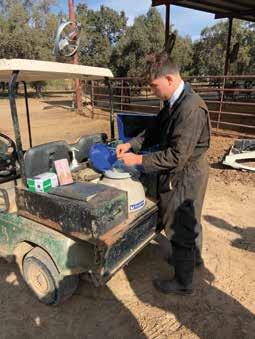 By: Branyon Bliss, El Capitan FFA Chapter Reporter
By: Branyon Bliss, El Capitan FFA Chapter Reporter
According the to National FFA Organization, “ A Supervised Agricultural Experience (SAE) is a student-led, instructor-supervised, work based learning experience that results in measurable outcomes within a predefined, agreed upon set of Agriculture, Food and Natural Resources Technical Standards and Career Ready Practices aligned to a Career Plan of study.” On December 6th eight students from the El Capitan FFA chapter participated in the Merced/Mariposa Sectional Project Competition. The competition provided students with the opportunity to share information about their SAE projects. Participants also gave a demonstration on their project showing a duty that is often required of them in their project. The demos performed by students ranged from GPS tractor operation, agrimarketing
product design, to a dairy cattle artificial insemination demonstration. Students exemplified what a daily routine is in their SAE project and were judged on factors including presentation, communication skills, difficulty of project and more. Project competition is a valuable competition for FFA members to compete in because it examines and builds public speaking skills and confidence when sharing about a topic they know very well. Students also learn to conduct themselves in a professional manner while communicating with an adult audience. Project competition is performed at many different levels. Numerous students participated in a local competition, where judges consist of El Capitan HS administrators and El Capitan Agriculture Advisory Board members.
From there, eight students were selected to participate in the sectional project competition, which consists of schools with an agriculture program
in Merced and Mariposa counties. The sectional competition is run by the Merced College Agriculture Department, and all schools are extremely thankful for the opportunity to participate in this competition. The sectional judges are individuals from Merced College, as well as agriculture industry representatives from across the central valley. Overall project competition is a great way for the community to see what agriculture education students do for their SAE project. El Capitan students had amazing demonstrations and we look forward to the results in the coming month. El Capitan FFA members who participated include Branyon Bliss (Crop Production), Adal Navarette (Meat Processing), Samantha Col (Veterinary Science), Henry Pariera (Dairy Cattle Production), Copeland Camp (Agrimarketing), Esther Navarro (Poultry Production), Zach Hunter (Crop Production/Agritourism), and Madysen Dietz (Sheep Production).







gets tough, we get going and kick into a higher gear. Our gears have been put to the test over the last few years with devastating wildfires, droughts and torrential rains. One can’t forget the grasshopper hatches that devour our rangelands and gardens every seven years or so. One thing is for sure, it’s never boring up here in the hills!
Mariposa County has a population of approximately 17,000 residents in an area of 1,463 square miles. We are a strong, supportive, close-knit community that sticks together through thick and thin. We are generous and supportive of those in need and strive to be good neighbors and excellent stewards of the land. When the going
The first month of the new year is bringing us historical rain totals and devastating flooding. The burn scar from the Oak Fire is dramatically adding to the deluge of debris that is clogging culverts and blocking roadways. The total rainfall in the scar area from December 27, 2022 through January 10, 2023 was 19.6 inches. It has been an enormous challenge for Mariposa County Public Works to keep our county functioning, roadways clear and our residents and animals safe and secure. Rural life becomes even more interesting and challenging during these natural disasters. We learn to appreciate the little things in life more, and never ever take anything for granted.
As we know all too well, the ongoing drought has lulled us into
a state of “Fair Weatherness.” We have been programed to conserve every drop of water possible and fret, over the fact that our stock ponds and springs could completely dry up, (and many have.) I must say that a lack of water for our animals is one of the most helpless feelings I’ve ever had. I know that every rancher feels the same way, it’s intensely stressful and totally exhausting! Thank the Lord for the much-needed rainfall, we’ll take what
we can get and be forever grateful.
As we prepare for several more inches of rain, and more than a few feet of snow in the high country we hope and pray that the drought is officially over. Wouldn’t that be wonderful?! In this new year and as always, I encourage farmers, ranchers and conservators to invite friends, neighbors and family members to join the collective voice of the Farm Bureau. Together, we can make our organization stronger than ever, one member at a time.
From small farms to large commercial operations, the INSURICA Agriculture Experts have grown up in agricultural communities.
We’ve designed insurance programs to provide broad and flexible coverage for both your personal and business needs.


 By: Dan Walters, CalMatters
By: Dan Walters, CalMatters
January 4, 2023 - California’s famous – or infamous – Proposition 13, passed by voters 44 years ago, sought to impose limits on state and local taxes.
The initiative, and several followup measures, imposed a direct cap on property taxes, created voting thresholds that made it more difficult to enact other taxes, and curbed the use of tax-like fees.
Although voters have rejected direct assaults on Proposition 13, politicians and pro-tax interest groups such as public employee unions have fought legal and political skirmishes with the anti-tax movement over what kinds of revenue-increasing instruments can be used to skirt constitutional restraints.
One potential clash this year is Gov. Gavin Newsom’s proposed financial penalties on oil companies that exceed still-to-be-specified limits on their profits. He initially proposed a tax on those profits, but a tax would require a two-thirds legislative vote, so Newsom
substituted financial penalties which, at least theoretically, would require only a simple majority vote.
However, the petroleum industry is branding the penalties as a tax, hinting that if Newsom’s measure becomes law, a legal challenge will be mounted on its constitutionality.
“A fee imposed on the industry as a commodity going to the government, that is going to look and act like a tax,” Kevin Slagle, spokesperson for the Western States Petroleum Association, said. “We know windfall taxes have been tried nationally and don’t work. What we need to do is focus on better public policy.”

A couple of years ago, the state Supreme Court handed pro-tax groups a major victory, declaring that although special purpose taxes proposed by local governments require two-thirds approval by voters, such taxes proposed by initiative ballot measure need just simple majority support from voters.
Writing the 5-2 majority opinion, Supreme Court Justice Mariano-
Florentino Cuéllar declared, “Multiple provisions of the state constitution explicitly constrain the power of local governments to raise taxes. But we will not lightly apply such restrictions on local governments to voter initiatives.”
The decision validated some local initiative tax measures that had failed to get two-thirds votes and touched off a flurry of new tax proposals using the initiative process, one of them being a highly controversial tax on property transfers of $5 million or more in Los Angeles.
In November, Los Angeles voters approved Proposition ULA by a nearly 3-to-2 margin – a clear majority but short of a two-thirds vote. It would generate between $600 million and $1.1 billion a year for low-cost housing, rent relief and programs to battle homelessness.
The city’s newly elected mayor, Karen Bass, is counting on the funds to help fulfill her pledge to alleviate the nation’s worst urban homelessness crisis.
However, if the tax is to take effect, its advocates must prevail in a lawsuit filed last month by the Howard Jarvis Taxpayers Association – named for Proposition 13’s late author – and local real estate interests, contending that the tax is prohibited by the state constitution and Los Angeles’ city charter.
The suit argues that “great and irreparable harm will result to plaintiffs, and to all Los Angeles property owners in being required to pay unconstitutionally imposed taxes,” adding, “Similar harm will occur to all Los Angeles residents in the form of increased rent and consumer prices resulting from the tax increase on all property sold (or value transferred) above $5 million.”
Given the huge amounts of money involved, it’s likely that the legality of the transfer tax will eventually reach the state Supreme Court and it could wind up on the same docket as a challenge to Newsom’s oil profits penalties.
Thus the never-ending saga of Proposition 13 enters a new phase.
To be included in the directory, join Merced County Farm Bureau as a business member by calling 723-3001.

J & F Fertilizer 854-6325
La Follette Enterprises, Inc. 632-1385
Mass Energy Works. (530) 710-8545
Machado Feed Company .................. 658-5943
Maciel & Co 777-0911
Mid Valley Ag Service 394-7981
Modern Dairy 722-7452
Modesto Dairy Supply ....................... 669-6200
Silva & Sons Custom Spreading 667-2566
Stone Family Spreading 756-1491
The Pollination Connection (877) 970-BEES (2337)
A V Thomas Produce ......................... 394-7514 Dallas Distributing Co 394-2803
Del Rio Nut Company 394-7945
The Morning Star Company .............. 826-8000
Minturn Huller Co-op (559) 665-1185
Parreira Almond Processing Co. 826-1262
Sensient Natural Ingredients (800) 558-9892
Yosemite Farms ................................. 383-3411
HARVESTING & HAULING
Baldes Hay Co ......................... (559) 718-9714
Bertuccio Hay 761-6247
Castillo Brothers Hay 392-3817
Diamond J Farms 564-0870
Minturn Huller Co-op .............. (559) 665-1185
Northern Merced Hulling 667-2308
Wallace & Son 382-0131
Allison Sierra, Inc. 966-4082
Agri-Valley Irrigation ......................... 384-8494
Dickey's Pump Service 394-3112
Irrigation Design & Construction, LLC387-4500
Pacific Southwest Irrigation 460-0450
Precision Aqua ................................... 756-2025
Quality Well Drillers 357-0675
Rain for Rent/Westside Pump (559) 693-4315
Robal
